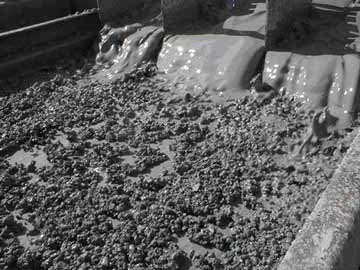Drilling Fluid Tests
| Drilling fluid tests are performed to evaluate the properties and characteristics of the fluid, and to determine its performance limitations. | ||||||||||||||||||||
|
Field Tests
The drilling-fluids specialist in the field conducts a number of tests to determine the properties of the drilling-fluid system and evaluate treatment needs.
Although drilling-fluid companies might use some tests that are designed for evaluating a proprietary product, the vast majority of field tests are standardized according to American Petroleum Institute Recommended Practices (API RP) 13B-1[1] and 13B-2,[2] for water-based fluids (WBFs) and oil-based fluids (OBFs), respectively.

The drilling-fluids specialist in the field conducts a number of tests to determine the properties of the drilling-fluid system and evaluate treatment needs.
Although drilling-fluid companies might use some tests that are designed for evaluating a proprietary product, the vast majority of field tests are standardized according to American Petroleum Institute Recommended Practices (API RP) 13B-1[1] and 13B-2,[2] for water-based fluids (WBFs) and oil-based fluids (OBFs), respectively.
- Table 1
shows typical API-recommended field tests for WBFs.

- Table 2
shows typical API-recommended field tests for OBFs and synthetic-based fluids (SBFs). Several tests are identical to those performed on WBFs. For all three fluid types, depending on the type of fluid in use, some or all tests should be performed.

Laboratory tests
Extensive testing of the fluid is performed in the design phase of the fluid, either to achieve desired fluid characteristics or to determine the performance limitations of the fluid.
Laboratory testing aids in fluid design and expands the capacity to monitor and evaluate fluids when field-testing procedures prove inadequate. Some laboratory tests are identical to field-testing methods, whereas others are unique to the laboratory environment. In the laboratory setting, testing and equipment are available to determine:
Extensive testing of the fluid is performed in the design phase of the fluid, either to achieve desired fluid characteristics or to determine the performance limitations of the fluid.
Laboratory testing aids in fluid design and expands the capacity to monitor and evaluate fluids when field-testing procedures prove inadequate. Some laboratory tests are identical to field-testing methods, whereas others are unique to the laboratory environment. In the laboratory setting, testing and equipment are available to determine:
- Fluid Rheology
- Fluid Loss
- Particle Plugging
- High-angle sag
- Dynamic high-angle s
- High-temperature fluid aging
- Cuttings erosion
- Shale stability
- Capillary suction
- Lubricity
- Return permeability
- Particle-size distribution (PSD)
- Fluid Rheology Fluid rheology is an important parameter of drilling-fluid performance. For critical offshore applications with extreme temperature and pressure requirements, the viscosity profile of the fluid often is measured with a controlled-temperature and -pressure viscometer (e.g., the Fann 75). Fluids can be tested at temperatures of 35°F to 500°F, with pressures of up to 20,000 psia. Cold-fluid rheology is important because of the low temperatures that the fluid is exposed to in deepwater risers. High temperatures can be encountered in deep wells or in geothermally heated wells. The fluid can be under tremendous pressure downhole, and its viscosity profile can change accordingly.
- Fluid loss If fluid (or filtration) loss is excessive, the following can occur:
- Formation instability
- Formation damage
- Fractured formation and loss of drilling fluid
-
In the field, LP/LT(Low Pressure/Low Temperature) and HP/HT(High Pressure/High Temperature) fluid-loss tests are performed routinely. Fluid loss also can be measured under dynamic conditions using the Fann 90 viscometer, which incorporates a rotating bob to provide fluid shear in the center of a ceramic-filter core. The fluid is heated and pressurized. Fluid loss is measured radially through the entire core, giving a sophisticated simulation of the drilling fluid circulating in the wellbore.
- Particle plugging The particle-plugging test (PPT) often is used to evaluate the ability of plugging particles added to a fluid to mitigate formation damage by stopping or slowing filtrate invasion into a core. A PPT uses an inverted HP/HT-filter-press cell that has been fitted with a ceramic disk as a filtering medium and is pressurized with a hydraulic cylinder. Ceramic disks with different mean pore-throat diameters are used to simulate a wellbore wall. A PPT typically is run with a 2,000-psi or higher differential pressure. The spurt loss and total fluid loss are measured over a 30-minute period. The cell is inverted, and fluid loss is measured from the top of the cell to eliminate the effects of fluid settling.
- High-angle sag and dynamic high-angle sag The weighting material used to increase the density of the drilling fluid can settle at a faster rate in an angled well than in a vertical well. The high-angle sag test (HAST) and dynamic high-angle sag test (DHAST) measure density differences in the fluid as the angle of drilling changes. The HAST is used with fluids under static conditions, whereas the DHAST is used under dynamic conditions, in which the fluid can be subjected to shear or observed statically. The DHAST has temperature and pressure specifications of 350°F and 10,000 psia, respectively. Measuring the changes in density allows the fluid’s propensity to undergo these changes in the drilling process to be evaluated and curtailed by modifications to the fluid design.
- High-temperature fluid aging Over time, high temperatures can degrade the components of a drilling fluid, and alter its performance. High-temperature aging of the fluid is conducted to assess the impact that temperatures > 250°F have on performance. Fluid can be aged statically and dynamically. In the static-aging process, the fluid is placed in a pressurized cell, and allowed to stand without rolling at the desired test temperature for a desired length of time (rarely < 16 hours). This simulates the stress the fluid might be subjected to during static periods in the wellbore (e.g., logging and tripping). In dynamic aging, the fluid is rolled in a pressurized cell at the desired test temperature to simulate the fluid under drilling conditions. After undergoing aging, the fluid can be evaluated using the same tests that are applied to non-aged fluid.
- Cuttings erosion If drilled cuttings undergo significant erosion before being removed from the drilling fluid, that fluid’s colloidal content can increase, and interfere with drilling performance. Also, cuttings erosion usually is accompanied by wellbore erosion, which leads to hole washout. Two tests are available to aid in designing fluids that reduce cuttings erosion. One is an API-approved method in which the user measures out a known amount of shale material that is representative of the formation to be drilled, and that has been broken and sized between No. 6 and No. 12 shaker screens. The shale then is placed in a jar, and exposed to the drilling fluid, where it is aged by hot-rolling it at 150°F for 16 hours. After aging, the shale is collected on the No. 12 shaker screen, carefully washed, and dried. The percent recovery is calculated on the basis of the weight of the recovered shale vs. that of the shale originally used. Variations of this method are used for individual component testing. The aging time is varied to determine the erosion rate. The second available test is the slake-durability tester, which measures chemical and mechanical erosion to the shale. This tester resembles the API-approved method in that it uses a known amount of test shale and in that recovery is calculated in the same way. It differs in that the shale sample is placed inside a mesh-screen cage that is immersed in the drilling fluid and rolled continually throughout the test.
- Shale stability Reactive shales cause many difficulties in a drilling operation. Fluids should be designed to mitigate these shale problems. Along with erosion testing, four other distinct tests are used to assess the interaction between the drilling fluid and shale: capillary suction time (CST), return permeability, X-ray diffraction and particle-size distribution (PSD).
- CST The CST test investigates the chemical effects of the drilling fluid on the dispersive properties of shale and active clays. The CST test measures filter-cake permeability by timing the capillary action of filtrate onto a paper medium. Changes in permeability then can be related to the inhibitive characteristics of the fluid.
- Return permeability When drilling reaches a hydrocarbon-bearing zone, of great concern is the potential to damage the formation and thereby to reduce the ability of the well to produce hydrocarbons. A return-permeability test can reveal formation damage, and can be conducted using a return permeameter. The porosity and conductivity of a core sample are determined by flowing a refined mineral oil through the core. To simulate fluid and filtrate invasion into the core, drilling fluid is placed against the outflow side of the core, and differential pressure is applied in the direction opposite that of the previous flow measurement. After contamination, mineral oil is flowed through the core in the original direction, and the resultant porosity is compared to the original porosity to determine whether a reduction in permeability has occurred.
- Particle-size distribution (PSD) PSD are determined for various solid materials that are added to drilling fluids. A particle-size analyzer determines PSD by measuring laser-light diffraction, which can be related to particle size. PSDs are used to determine what screen size is needed for removing particles from the fluid system for conditioning, whether the particles present are small enough to cause formation damage by becoming trapped in the formation’s pores, and whether the present distribution of particle sizes will allow effective bridging of pore openings to help control fluid loss without causing excessive formation damage.
Drilling Fluids Testing
-
Drilling fluid Testing to support client oil and gas E&P operations.
SKILs staff bring expertise to drilling fluid projects, and can modify or tailor existing tests to address specific drilling problems. Drilling fluid analysis, problem solving, rig-site assistance, training, and audits are available. SKILs also provide Drilling Fluids school training programs.
- Drilling fluids testing includes API and ASTM procedures:
- Rheology
- Fluid-Loss Characteristics
- Filtrate Ion Analysis
- Solids Analysis
- API Specification Tests
- Drill Mud Contamination
- Specialized drilling fluids testing:
- High-Pressure, High-Temperature Viscometry
- Dynamic Fluid-Loss Analysis
- Lubricity Coefficient of Friction Measurements for Metal/Metal, Metal/Sandstone, Metal/Shale, Metal/Filter Cake Contact Surfaces
- Shale-Fluid Interaction Analysis
- Gas Hydrates/Mud Phase Behaviors
- High-Pressure, High-Temperature Viscometry
- Drilling Fluid rig site assistance, consulting and auditing: SKILs staffs have years of field and laboratory experience, and are available to provide rig site assistance for problem wells. SKILs experts develop and deliver training in drilling fluid technology, ranging from basic overviews to advanced programs. The independent status of the SKILs. laboratory provides clients with accurate, objective and unbiased evaluations and reviews of drilling fluid issues, drilling fluid projects and drilling programs.
- Focused drill fluid research, consulting and training: The SKILs drilling fluids group undertakes applied research, technical training programs and consulting assignments. SKILs maintain a leadership role in drilling fluid technology by active participation in Joint Industry Research Programs.
Products and Fluid Systems
-
SKILs has introduced an effective group of proprietary products and fluid systems incorporating novel new components designed to advance the science of drilling demanding wells under harsh conditions.

Our approach is two-fold: Achieving new synergies of performance by combining existing technologies into a single package; and developing totally new approaches in mud chemistry. As a result, SKILs has rolled out a growing number of new cost-effective products maximizing our customers’ drilling performance.
Our technological experts match performance criteria with cost-effective tools, refining and perfecting application techniques to provide solutions to a wide range of geological challenges.

Central to this development is SKILs’s respect for the environment. That respect has led to breakthroughs such as SKILs polyoil/DeepDrill™ water based drilling fluids (as an alternative to invert emulsion systems). Likewise, SKILs has introduced a variety of proprietary products to provide solutions to age-old drilling challenges such as shale stabilization, inhibition and penetration rates. How can these products and systems solve your drilling challenges?
